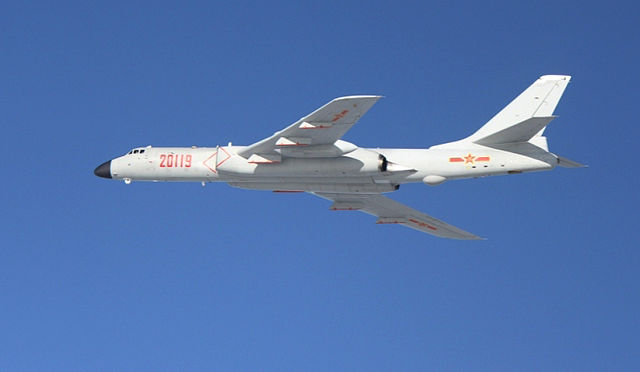Giuseppe Sandro Mela.
2018-05-08.
«China is developing a nuclear-capable air-launched ballistic missile, likely based off the DF-21»
*
«China is developing and has been flight-testing a nuclear-capable air-launched ballistic missile (ALBM) along with a new long-range strategic bomber to deliver it»
*
«The two most recent tests of the system involved aerial launches off a modified H-6K strategic bomber capable of being refueled while in the air»
* * * * * * *
A quanto è dato sapere al momento attuale, il raggio di azione dell’H-6k sarebbe di circa 3,000 kilometri: molti in senso assoluto, pochi se commisurati allo scacchiere dell’Oceano Pacifico.
Sempre a quanto riferito
«The CH-AS-X-13, meanwhile, is a two-stage, solid-fuel ballistic missile with a 3,000 kilometer range; it is likely a variant of the DF-21 medium-range ballistic missile»
In sintesi, il raggio di azione bombardiere – missili non supererebbe i 6,000 kilometri complessi: questa arma potrebbe quindi svolgere più un compito nella parte occidentale dell’Oceano Pacifico, difficilmente su distanze maggiori.
*
«Sviluppato a partire dal 2000, l’H-6K rappresenta un notevole passo in avanti sia per prestazioni di volo che per capacità belliche. Il nuovo modello ha volato nel 2007 entrando in servizio intorno al 2010. Rispetto ai predecessori il velivolo è stato radicalmente ammodernato, con la sezione anteriore della fusoliera e il raccordo con il cockpit sono stati modificati ed il naso vetrato è stato sostituito da uno solido di elettrico. Nella sezione anteriore ventrale della fusoliera è stata installata una torretta elettro-ottica e lungo la fusoliera sono comparse una serie di antenne per la guerra elettronica (ECM, ESM), mentre dietro la baia armi è presente una carenatura che potrebbe nascondere l’antenna di datalink per la variante lanciabile da aereo del missile da crociera a lungo raggio CJ-10/KD-20. Sulla deriva verticale, inoltre, sono presenti le antenne dei sistemi RWR (Radar Warning Receiver) e MWR (Missile Warning Receiver). Ulteriore spazio per altri apparati avionici è stato, infine, ricavato rimuovendo la torretta per il cannone da 23 mm in coda. La cellula è stata rinforzata in diverse parti e dovrebbero essere stati impiegati pure materiali compositi. Il velivolo è stato rimotorizzato e al posto dei due turbogetti Xian WP8 (copia del Mikulin RD-3M che spingeva il Tu-16) sono stati installati i più potenti e moderni turboventola Saturn D-30KP-2, ciascuno tarato per erogare fino a 23.150 libbre (103kN) di spinta, che ha comportato anche l’allargamento delle prese d’aria. Un’altra modifica importante è stata la soppressione della stiva armi interna, il cui spazio è stato riutilizzato per ospitare ulteriore carburante, aumentando l’autonomia ed il raggio d’azione del velivolo. Le fonti concordano nel ritenere che l’autonomia del velivolo sia pari a circa 3.500 km. Il velivolo è così armato “solo” con 6 missili KD-20, 3 per ogni semiala, con 2.000 km di portata, che fa si che l’H-6K potrebbe colpire bersagli strategici fino a Guam, Alaska ed Hawaii restando entro la copertura delle difese aeree amiche» [Fonte]
